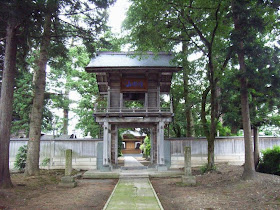This is a series of posts describing the many varieties of Japanese gate, or mon (門). If you look at the preceding kanji
more closely, you can think of it as a picture of a pair of swinging
doors, reminiscent of saloon doors in a wild west movie. I thought
that it would be a nice idea to bring more awareness to a western audience as
to the tremendous diversity in forms and types of Japanese gates. This
series intends to be a gateway to gates.
Previous posts in this series:
------------------
Shōrōmon (鐘楼門)
A cherry tree (楼) gate (門) with the upper story functioning as a bell (鐘) tower. A stand-alone bell tower is termed a shōrō (鐘楼). There are bell towers and bell tower gates.
As with rōmon (see previous post) there are four-legged and eight-legged versions of shōrōmon. Let's look at a few examples of the four-legged type first.
Another view provides a glimpse of the bell on the second floor:
While the exterior form of these gates is the same as we saw in our previous post looking at rōmon, the one key difference is that the second floor is actually used for something, and thus there is access to the upper floor by way of a ladder or staircase. Alternatively, the cord attached to the shumoku hangs down through the floor structure so that the bell can be rung from ground level.
Another four-legged shōrōmon:
A view from the back reveals the ladder and the bell's wooden striker, or shumoku (撞木):
One more four-leg version, at Daichūji:
Now for a look at eight-legged shōrōmon, which appear to be the more common type to come across.
This first one has such a narrow base that it is close in form to the four-legged type - in fact it is debatable how many legs one would suggest for labeling purposes:
A more 'typical' eight-legged shōrōmon, one can say there is such a thing:
The above gate was constructed between 1716 and 1735. You will note that although it is called an 'eight-leg' gate, in reality there are 12 supporting posts. This is a similar situation to the way four legged gates are labeled, which is on the basis of the count of auxiliary support posts, or hikae-bashira.
Another example, at Kanonji:
As with some stand-alone bell towers, there are shōrōmon, in four- or eight legged variants, which have their lower posts and associated timber work enclosed within a skirt-shaped enclosure, or hakama-goshi. The bell tower gate at Manjuji in Kyoto:
And with a certain sect of Buddhism - I haven't been able to nail down which one it is at the time of writing with total surety - I think it is Nichiren Buddhism - that hakama-goshi is formed in a curvilinear manner and often painted/plastered white. At Honganji there is an example:
One last example shows the same curvilinear lower skirt enclosure, not painted white this time. Nyorinji in Chiba Prefecture:
A beautiful example of double-curvilinear work, and fan-raftering, or ōgi-daruki.
You'll find that clicking on any of the above pictures should provide you with some nice wallpaper for your screen. Thanks for coming by the Carpentry Way. On to the next post.












Question...Going back to post number five and the first gate at the top of the page. This old structure has a very wide...extreme sweep on the bardge rafters. I am wondering what that piece was cut out of. It seems that in order get that much of a radius you need to start with a very wide plank of wood. Was that piece possibly bent or could it have come from a branch that already had that shape??
ReplyDeleteChris...sorry, I didnt really see the hafu in detail until yeasterday. I had exactly the same idea and you confirmed it on the shaping of planks. In todays building work I highly doubt that any carpenter and patron could afford to use a solid plank for an extreme curve like that. Splicing is common: maybe several boards would be needed. I guess the splice joints would show...looking like a seamless butt joint.
DeleteWard, thanks for your question, and it would be great if you had posted it at the bottom of the post (#5) in question. I receive an automatic notification whenever a comment is posted, even from posts from years back, so you can be sure I will get to it. It's all good though!
DeleteAs to your question, with curved barge boards, or hafu-ita, there are only three traditional solutions I'm aware of:
-The board comes from a very wide plank
-The board is spliced together with two or more pieces
-the board was sliced from a bowed log
Though to prevent warping when using bowed log stock it is best, I think, to obtain the board from a thick log so you can cut the curved piece out from one side of the heart, or the other. Since bowed logs have a lot of compression grain on one side and tension grain on the other, slicing through and through, leaving compression on one side of the board and tension on the other, with the heart having it's own tangential grain contributions, is often going to induce strong distortions and warps in the board.
A curved branch is often a worse choice than a bowed log, since the branch usually has even more acute tension loads on it, having grown out laterally from the trunk and curved up.
I have seen splicing used very commonly for curved hafu ita.
~C
Not related to this post but thought you might enjoy this structure being built in Hawaii. The slideshow on the page has some interesting pictures. All the best
ReplyDeletehttp://www.lawaicenter.org/pages/temple.html
Shawn,
Deletethanks for your comment and sharing the link!
~C